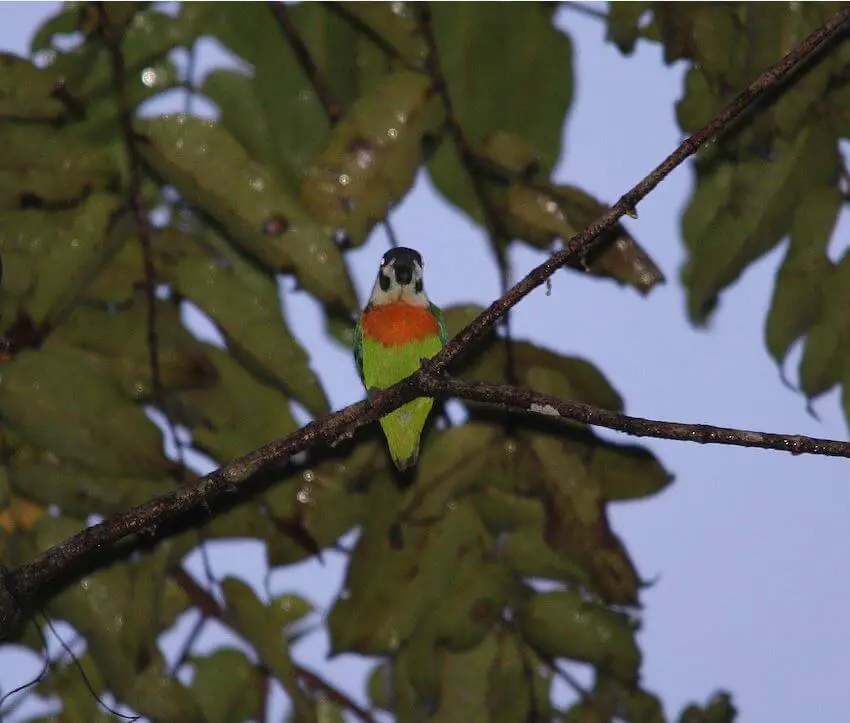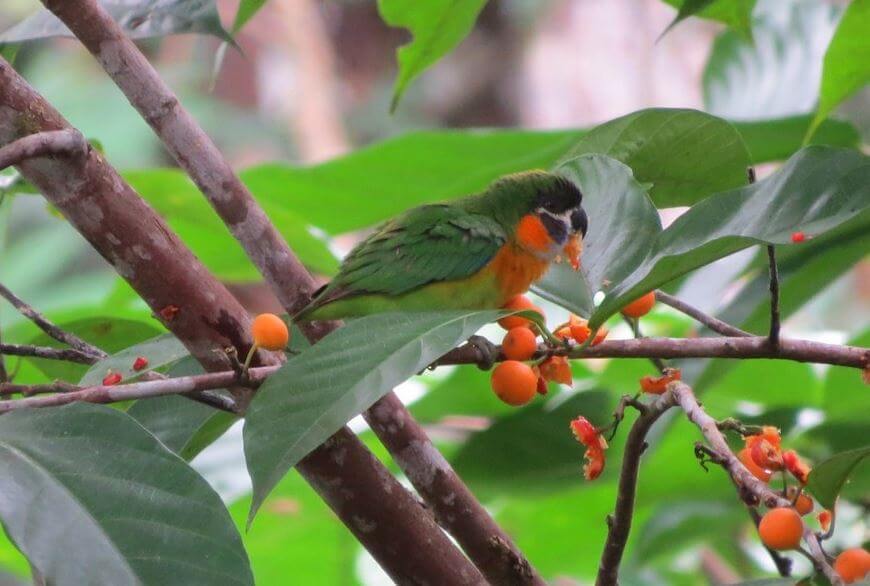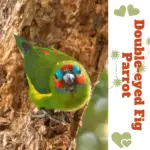Orange-breasted Fig Parrot (Blue-fronted)
11–13 cm; 27–34 g. Dark green above; forehead to below and behind eye dark blackish-blue; lores, throat and sides of head pale yellow; breast and upper belly orange; lower belly to vent yellowish green; flight-feathers dark blue.
Female has orange ear-coverts, dark border to yellow lores and cheeks, formed by a black patch that runs down below eye, and greenish breast. Bare parts: bill black, iris brown, and legs and feet grey. Immature not clearly described, but apparently similar to female.
Orange-breasted Fig Parrot (Black-fronted)

11–13 cm; 27–34 g. Previously considered to be conspecific with C. gulielmitertii (see Taxonomy comments). Dark green above; forehead to below and behind eye black;
lores, throat and sides of head very pale yellow, with a comma-shaped black mark on fore ear-coverts; breast and upper belly orange; lower belly to vent yellowish green; flight-feathers dark blue.
The Female also has a very pale yellow face (unlike C. gulielmitertii, it does not have orange rear ear-coverts), with an even more prominent comma-shaped dark patch, and has a very faint and smaller patch on underparts (restricted to the upper breast). Immature not clearly described, but presumably very similar to female.
Orange-breasted Fig Parrot (Creamy-breasted)
11–13 cm; 27–34 g. Previously considered to be conspecific with C. gulielmitertii (see Taxonomy comments), which is a larger bird (wing 91–97 mm, versus mean 83·6 mm innominate of present species, or mean 82·5 mm in race amanuensis).
Dark green above; forehead to below and behind eye dark blackish; sides of head, throat, breast and upper belly very pale yellow, without any black markings on ear-coverts; lower belly to vent yellowish green; flight-feathers dark blue.
Female has black crown and very large vertical black patch dividing whitish-yellow or ivory-white ear-coverts and fore-face, and pale orange breast with paler feather tips.
Immature not clearly described, but presumably similar to female as in other members of the complex. Race amanuensis is similar to nominate but has a variable mixture of blue and black in the crown.
Orange-breasted Fig Parrot (Dusky-cheeked)

11–13 cm; 27–34 g. Previously considered to be conspecific with C. gulielmitertii (see Taxonomy comments), the present species is markedly smaller than (wing of male mean 77·3 mm,
thus also marginally smaller than C. amabilis, which was also previously considered conspecific with C. gulielmitertii). Dark green above; forehead to below and behind eye brown;
lores, throat and sides of head whitish, with the large patch below the eye; breast and upper belly orange; lower belly to vent yellowish green; flight feathers dark blue, and has whitish underwing stripe.
The Female has a similar face pattern, but a much larger black patch separating the throat and ear-coverts, paler orange breast, and blue forehead.
Immature not clearly described, but presumably similar to female-like in other members of C. gulielmitertii complex. Race suavissima like nominate but forehead darker, while female differs more obviously having a blue face,
white mark at the base of the bill and behind the eye, orange ear-coverts, and an orange suffusion to green breast; fuscifrons (slightly larger than nominate, with the wing of male mean 80·2 mm)
is basically like suavissima but the male has a blackish forecrown, less orange on the breast, a smaller black cheek patch and a whitish throat, while the female is also like suavissima, but the blue of the face is replaced by black (except on throat-sides).
Systematics History

Editor’s Note: This article requires further editing work to merge existing content into the appropriate Subspecies sections. Please bear with us while this update takes place.
Orange-breasted Fig Parrot (Blue-fronted)
Hitherto is usually treated as conspecific with C. nigrifrons, C. amabilis and C. melanogenia (see under those species). Monotypic.
Orange-breasted Fig Parrot (Black-fronted)
Hitherto is usually treated as conspecific with C. gulielmitertii, C. amabilis and C. melanogenia, but differs from the last two in characters given under those species, and from gulielmitertii in its black vs blue forehead to mid-crown and line behind eye;
larger black mark on the cheek in male; whitish rear ear-coverts to chin vs orange ear-coverts and blue chin patch adjoining black cheek mark in female. Monotypic.
Orange-breasted Fig Parrot (Creamy-breasted)
Hitherto is usually treated as conspecific with C. nigrifrons, C. gulielmitertii and C. melanogenic, but differs from melanogenic in characters given under that species, and from nigrifrons and gulielmitertii in its creamy-yellow cheek to mid-belly in male;
lack of cheek mark in males; strongly peach-coloured breast in females (2 vs nigrifrons, 3 vs gulielmitertii); and (vs gulielmitertii only) black vs blue crown (ns[3]). Two subspecies were recognized.
Orange-breasted Fig Parrot (Dusky-cheeked)
Hitherto is usually treated as conspecific with C. gulielmitertii, C. nigrifrons and C. amabilis, but differs from these in its whitish underwing-stripe vs all plain dark brown underwing and large cheek patch in females, plus (vs gulielmitertii) whitish vs yellow face colour (ns[2]) and cheek patch size in male;
(vs nigrifrons) whitish vs yellow face colour (2) and crown colour in male (ns[2]); and (vs amabilis) in latter’s creamy-yellow underparts and lack of cheek mark in male (3). Three subspecies were recognized.
Distribution
Orange-breasted Fig-Parrot (Blue-fronted)
NW New Guinea: Salawati and lowlands of Vogelkop Peninsula and possibly of Bomberai and Onin Peninsulas (recently recorded in N Onin Peninsula).
Orange-breasted Fig-Parrot (Black-fronted)
N New Guinea between E Geelvink Bay and Sepik R.
SOURCE: Bird Jamboree
Habitat

Orange-breasted Fig-Parrot (Blue-fronted)
Rain- and monsoon forest, gallery and savanna woodland, Melaleuca swamp forest, partly cleared areas, in lowlands and hills up to 1100 m (but rarely recorded above 800 m).
Orange-breasted Fig-Parrot (Black-fronted)
No known differences from C. gulielmitertii.
Orange-breasted Fig-Parrot (Creamy-breasted)
No known differences from C. gulielmitertii.
Orange-breasted Fig-Parrot (Dusky-cheeked)
No known differences from C. gulielmitertii. Nominate occurs only to 300 m on Aru Is.
Migration Overview
Orange-breasted Fig-Parrot (Blue-fronted)
Sedentary.
Orange-breasted Fig-Parrot (Black-fronted)
Presumably sedentary like C. gulielmitertii.
Orange-breasted Fig-Parrot (Creamy-breasted)
Presumably sedentary like C. gulielmitertii.
Orange-breasted Fig-Parrot (Dusky-cheeked)
Presumably sedentary like C. gulielmitertii.
Diet and Foraging
Orange-breasted Fig-Parrot (Blue-fronted)
Seeds of figs (Ficus) are probably the main staple, but also seeds of Glochidion, whose fruits are broken apart, and Acacia auriculaeformis; also apparently the inflorescences of Poikilospermum. Typically encountered in small groups of 6–10 birds, especially in the canopy but also regularly in lower storeys.
Orange-breasted Fig-Parrot (Black-fronted)
No known differences from C. gulielmitertii.
Orange-breasted Fig-Parrot (Creamy-breasted)
No known differences from C. gulielmitertii.
Orange-breasted Fig-Parrot (Dusky-cheeked)
No known differences from C. gulielmitertii.
Sounds and Vocal Behavior
Orange-breasted Fig-Parrot (Blue-fronted)
In-flight gives a shrill, frequently repeated: “tseet” considered to be similar to that of C. diophthalma but sweeter and higher-pitched, while also utters an explosive and chirping “chip-chip-chip” like small coins being clicked together,
also subdued chattering and wheezing calls while feeding, a high-pitched staccato “kss” and a short “ts” reminiscent of Charmosyna placentas, but less sharp, shrill or grating than that species.
Orange-breasted Fig-Parrot (Black-fronted)
No known differences from C. gulielmitertii, with which previously considered conspecific, although vocalizations within the group have not been well studied.
Orange-breasted Fig-Parrot (Creamy-breasted)
No known differences from C. gulielmitertii, with which previously considered conspecific, although vocalizations within the group have not been well studied.
Orange-breasted Fig-Parrot (Dusky-cheeked)
No known differences between this species and C. gulielmitertii, which were previously considered conspecific, although vocalizations within the group have not been well studied.
Breeding

short-tailed parrot (Blue-fronted)
Dec–Jun, but nest cavity visits and advertisement in Sept-Oct, when begging juveniles also noted. A nest is usually assumed to be in a hole excavated in an arboreal termitarium, with two or more active nests found in the same mound, but also reported to nest in epiphytes.
In captivity, accepts nest boxes and lays two (perhaps 1–3) white eggs, incubated 20–22 days, with a nestling period of 35–42 days.
short-tailed parrot(Black-fronted)
No known differences from C. gulielmitertii.
short-tailed parrot (Creamy-breasted)
No known differences from C. gulielmitertii.
short-tailed parrot(Dusky-cheeked)
No known differences from C. gulielmitertii.
Conservation Status
short-tailed parrot(Blue-fronted)
Not globally threatened. CITES II. Like C. nigrifrons and C. amabilis, this species is probably generally uncommon to rare.
There is no population estimate for the species, but in the late 1990s, it was suggested that the overall population of the C. gulielmitertii superspecies (including C. nigrifrons, C. amabilis and C. melanogenic) might be in the region of 100,000 pairs.
short-tailed parrot(Black-fronted)
Not globally threatened. CITES II. Like C. amabilis and C. gulielmitertii, this species is probably generally uncommon to rare.
There is no population estimate for the species, but in the late 1990s, it was suggested that the overall population of the C. gulielmitertii superspecies (including C. amabilis, the present species and C. melanogenic) might be in the region of 100,000 pairs.
short-tailed parrot(Creamy-breasted)
Not globally threatened. CITES II. Like C. nigrifrons and C. gulielmitertii, this species is probably generally uncommon to rare.
There is no population estimate for the species, but in the late 1990s, it was suggested that the overall population of the C. gulielmitertii superspecies (including C. nigrifrons, the present species and C. melanogenic) might be in the region of 100,000 pairs.
short-tailed parrot (Dusky-cheeked)
Not globally threatened. CITES II. Common at Crater Mountain and other parts of S of range, where at one site density estimated at 30 birds/km², and at Ok Tedi in WC Papua New Guinea (subspecies unknown).
There is no population estimate for the species, but in the late 1990s, it was suggested that the overall population of the C. gulielmitertii superspecies (including C. nigrifrons, C. amabilis and the present species) might be in the region of 100,000 pairs.
SOURCE: Video Ark





















